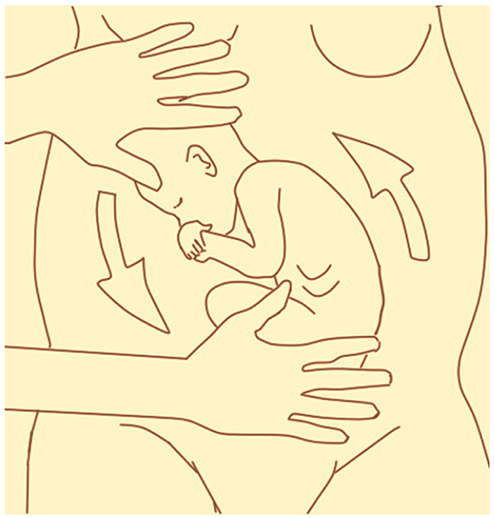External cephalic version experiences in Korea
- Affiliations
-
- 1Department of Obstetrics and Gynecology, Chung-Ang University Hospital, Chung-Ang University College of Medicine, Seoul, Korea. gjkim@cau.ac.kr
- KMID: 2159001
- DOI: http://doi.org/10.5468/ogs.2016.59.2.85
Abstract
OBJECTIVE
The aim of this study was to evaluate obstetric outcomes of external cephalic version (ECV) performed at or near term.
METHODS
Single pregnant woman with breech presentation at or near term (n=145), who experienced ECV by one obstetrician from November 2009 to July 2014 in our institution were included in the study. Maternal baseline characteristic and fetal ultrasonographic variables were checked before the procedure. After ECV, the delivery outcomes of the women were gathered. Variables affecting the success or failure of ECV were evaluated.
RESULTS
Success rate of ECV was 71.0% (n=103). Four variables (parity, amniotic fluid index, fetal spine position and rotational direction) were observed to be in correlation with success or failure of ECV. In contactable 83 individuals experienced successful ECV, cesarean delivery rates were 18.1%, 28.9%, and 5.3% in total, nulliparas, and multiparas, respectively.
CONCLUSION
Based on the results, ECV is proposed to be safe for both mother and her fetus. In addition, it is a valuable procedure that increases probability of vaginal delivery for women with breech presentation.
MeSH Terms
Figure
Cited by 3 articles
-
Evaluation of the learning curve for external cephalic version using cumulative sum analysis
So Yun Kim, Jung Yeol Han, Eun Hye Chang, Dong Wook Kwak, Hyun Kyung Ahn, Hyun Mi Ryu, Moon Young Kim
Obstet Gynecol Sci. 2017;60(4):343-349. doi: 10.5468/ogs.2017.60.4.343.Height of elevated fetal buttock for prediction of successful external cephalic version
Jun Yi Lee, Yeorae Kim, In Sook Sohn, You Jung Han, Jin Hoon Chung, Moon Young Kim, Min Hyoung Kim, Hyun-Mee Ryu, SungHong Joo, Jung Yeol Han
Obstet Gynecol Sci. 2020;63(1):13-18. doi: 10.5468/ogs.2020.63.1.13.Ritodrine in external cephalic version: is it effective and safe?
Sin Ae Kim, Eun-Hwan Cha, Kyoung-Chul Chun, Young Ah Kim, Jae-Whoan Koh, Jung Yeol Han, Jong Hee Hwang
Obstet Gynecol Sci. 2022;65(5):420-429. doi: 10.5468/ogs.22106.
Reference
-
1. Centers for Disease Control and Prevention. Births: method of delivery [Internet]. Atlanta (GA): Centers for Disease Control and Prevention;c2015. cited 2015 July 17. Available from: http://www.cdc.gov/nchs/fastats/delivery.htm.2. Chung SH, Seol HJ, Choi YS, Oh SY, Kim A, Bae CW. Changes in the cesarean section rate in Korea (1982-2012) and a review of the associated factors. J Korean Med Sci. 2014; 29:1341–1352.3. Kok M, Cnossen J, Gravendeel L, Van Der Post JA, Mol BW. Ultrasound factors to predict the outcome of external cephalic version: a meta-analysis. Ultrasound Obstet Gynecol. 2009; 33:76–84.4. Committee on. Gynecology, American College of Obstetrics and Gynecologists. External cephalic version. Int J Gynaecol Obstet. 2001; 72:198–204.5. Chan LY, Tang JL, Tsoi KF, Fok WY, Chan LW, Lau TK. Intrapartum cesarean delivery after successful external cephalic version: a meta-analysis. Obstet Gynecol. 2004; 104:155–160.6. Bradley-Watson PJ. The decreasing value of external cephalic version in modern obstetric practice. Am J Obstet Gynecol. 1975; 123:237–240.7. Hofmeyr GJ, Kulier R. External cephalic version for breech presentation at term. Cochrane Database Syst Rev. 2012; 10:CD000083.8. Boucher M, Bujold E, Marquette GP, Vezina Y. The relationship between amniotic fluid index and successful external cephalic version: a 14-year experience. Am J Obstet Gynecol. 2003; 189:751–754.9. Newman RB, Peacock BS, VanDorsten JP, Hunt HH. Predicting success of external cephalic version. Am J Obstet Gynecol. 1993; 169(2 Pt 1):245–249.10. Kok M, van der Steeg JW, van der Post JA, Mol BW. Prediction of success of external cephalic version after 36 weeks. Am J Perinatol. 2011; 28:103–110.11. Burgos J, Melchor JC, Cobos P, Centeno M, Pijoan JI, Fernandez-Llebrez L, et al. Does fetal weight estimated by ultrasound really affect the success rate of external cephalic version? Acta Obstet Gynecol Scand. 2009; 88:1101–1106.12. Kirkinen P, Ylostalo P. Ultrasonic examination before external version of breech presentation. Gynecol Obstet Invest. 1982; 13:90–97.13. Vezina Y, Bujold E, Varin J, Marquette GP, Boucher M. Cesarean delivery after successful external cephalic version of breech presentation at term: a comparative study. Am J Obstet Gynecol. 2004; 190:763–768.14. Chan LY, Leung TY, Fok WY, Chan LW, Lau TK. High incidence of obstetric interventions after successful external cephalic version. BJOG. 2002; 109:627–631.15. Kuppens SM, Hutton EK, Hasaart TH, Aichi N, Wijnen HA, Pop VJ. Mode of delivery following successful external cephalic version: comparison with spontaneous cephalic presentations at delivery. J Obstet Gynaecol Can. 2013; 35:883–888.16. Lau TK, Lo KW, Rogers M. Pregnancy outcome after successful external cephalic version for breech presentation at term. Am J Obstet Gynecol. 1997; 176(1 Pt 1):218–223.17. de Hundt M, Velzel J, de Groot CJ, Mol BW, Kok M. Mode of delivery after successful external cephalic version: a systematic review and meta-analysis. Obstet Gynecol. 2014; 123:1327–1334.18. Jeong EH, Park KH, Ryu A, Oh KJ, Lee SY, Kim A. Clinical and sonographic parameters at mid-trimester and the risk of cesarean delivery in low-risk nulliparas. J Clin Ultrasound. 2014; 07. 12. DOI: 10.1002/jcu.22212.19. Kim SN, Park KH, Jung HJ, Hong JS, Shin DM, Kang WS. Clinical and sonographic parameters at 37 weeks' gestation for predicting the risk of primary cesarean delivery in nulliparous women. Ultrasound Obstet Gynecol. 2010; 36:486–492.20. Clock C, Kurtzman J, White J, Chung JH. Cesarean risk after successful external cephalic version: a matched, retrospective analysis. J Perinatol. 2009; 29:96–100.
- Full Text Links
- Actions
-
Cited
- CITED
-
- Close
- Share
- Similar articles
-
- External Cephalic Version Attempted under Epidural Anesthesia : Case reports
- Reviving external cephalic version: a review of its efficacy, safety, and technical aspects
- Ritodrine in external cephalic version: is it effective and safe?
- Rupture of Unscarred Uterus Detected during a Cesarean Section : A case report
- Evaluation of the Success Rate Following Amnioinfusion in Pregnant Women Undergoing External Cephalic Version after Initial Failure


